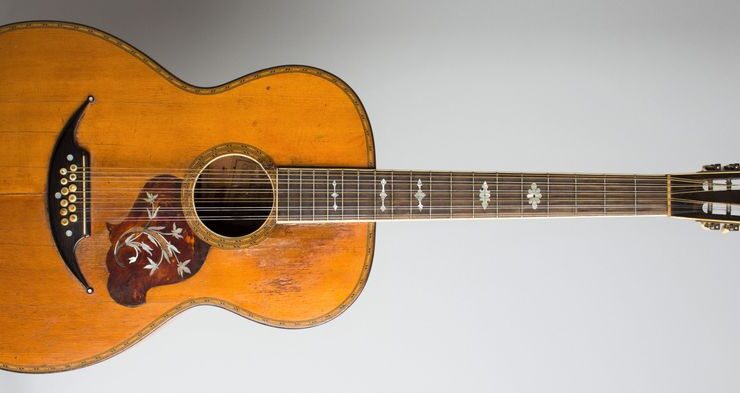
This post was originally published on this site

In the pre-internet age, guitar hunting was a “shoe leather” pursuit, requiring continuously scouring music stores, pawnshops, junk stores, small ads, and flea markets. Late one Sunday back in the mid 1990s, I had scorelessly scoped the fleas and antique dealers around 26th St. and 6th Ave. in Manhattan before idly heading west to the usually barren “junk” fields that cropped up on 7th Ave.
Suddenly, hanging from a wire fence, this 12-string loomed into sight, but what a sorry sight it was. The detached back and several braces were stuffed into a shopping bag. The bridge was splintered, the top a nest of cracks, and all covered with a veneer of grime. The sad-looking wreck, tagged at $100, had been there all day. After a quick perusal (while silently calculating luthier bills), I proffered the classic end-of-the-day “50 bucks on that?” I got the dealer’s weary side-eye, but quickly accepted his predictable $75 counter. Later showing off my find to guitar friends, the general opinion was it had been better left hanging!
And yet, luthier Bill Merchant was willing to undertake the project. He sealed the many cracks in the top and reattached the badly shrunken back, adding extra center strips to fit it to the rim. He also reset the neck and crafted an exact replica bridge and bridge plate. Recently, after decades under tension, the top was beginning to fold up around the soundhole—so luthier Amy Mills added diagonal wing braces on either side to stabilize it. We left the extensive playwear (including missing pieces of the inlaid pickguard) unaltered, as it befits this battered but beautiful survivor of a unique time and place in New York musical history.
This guitar was made within walking distance of where I found it, on Kenmare St. in Manhattan. What’s left of the label reads “A. Galiano, fabbricante di Chitarre e Mandolini.” There was no “A. Galiano”; the name was a sort of generic brand shared by several small NYC Italian-American music shops from the 1910s into the Depression. The term “Italian Guild” has been applied to them, but there was no organized guild, just sometimes interrelated-but-independent immigrant luthiers working in New York’s bustling Italian community.
“Suddenly, hanging from a wire fence, this 12-string loomed into sight, but what a sorry sight it was.”
One such luthier was Raphael Ciani, often remembered as John D’Angelico’s uncle and mentor. A few Galianos also have “Ciani” on the label; identical features allow others to be attributed to him. Ciani appeared in New York dealing musical goods by 1904. By 1913, he had settled his shop at 57 Kenmare St., a block from where D’Angelico would set up in 1932. John was born in 1905; by around age 9, he was already apprenticing in Ciani’s shop.
Raphael died in 1923 at the young age of 44, leaving the 18-year-old D’Angelico in charge of the shop. Ciani/Galiano instruments of the 1920s were built under John’s supervision, if not by his own hand. Survivors include different styles of mandolins and rare 6- and 12-string maple-bodied flattops like this one, a distinctive shop specialty in the 1920s. Before f-hole archtops existed, these steel-string Galianos were intended for ensemble use, built to compete with accordions and violins and to cut through the din in cafes, restaurants and vaudeville theaters. Mostly associated with Piedmont blues players or Mexican performers like Lydia Mendoza, 1910–’20s 12-string guitars were cited at the time for supposedly offering the greatest possible volume.
This is a large guitar for the period, 16 1/8″ wide and 4 1/2″ deep, with a 26″ scale. It has solid maple back and sides and a spruce top bordered with colored-wood marquetry and bound in rosewood. The mandolin-style celluloid pickguard with inset pearl is inlaid into the top. The swooping “mustache” bridge sits over a wide, flat bridge plate and ladder bracing. The one-piece, soft-V mahogany neck has a bound “ebonized” fretboard with a common New York-shaped pearl inlay pattern. The initials “JV” are inlaid in pearl on the bound headstock. Such Ciani/Galianos can rarely be dated exactly, but a similar 6-string guitar exists with “July 15 ’22” on the label.
Only a handful of these deluxe maple Ciani/Galianos are still in existence. The National Music Museum in South Dakota has an even more ornate 12-string. Country pioneer Ernest Stoneman played a similar jumbo 6-string that lacked the inlaid pickguard and personalized headstock. He likely obtained it during 1925–’26 New York recording trips. Before his Gibson endorsement, Nick Lucas’ 1922 Pathé Actuelle recordings “Teasing the Frets” and “Picking the Guitar” (the first recorded flatpicked guitar instrumentals) were almost certainly waxed with a Ciani/Galiano. In a 1970s interview, Lucas related buying the guitar in New York for $35 in the early ’20s.
About a century along, this Galiano 12-string remains a fully playable instrument, offering a powerful, bright-but-still-mellow sound and plenty of volume. If relegated to historical footnotes now, the best Ciani/Galiano instruments were not only beautiful but advanced for their time. Raphael Ciani did not live to see it, but his protégé would build on what they accomplished in the next decade, becoming the defining master of the archtop guitar.






